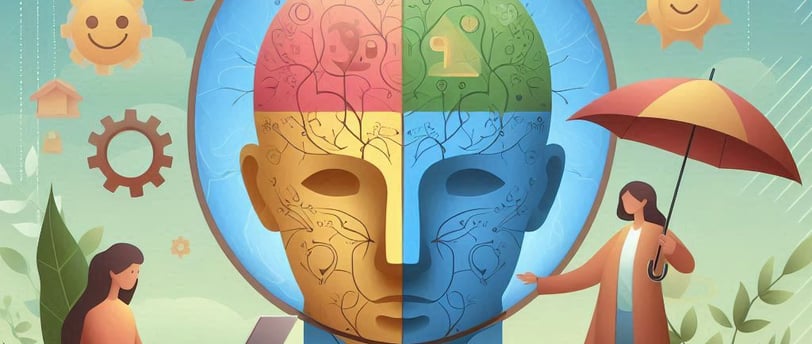Understanding Its Importance, Benefits, and Ways to Improve It
Emotional stability is a cornerstone of mental and physical well-being. By developing self-awareness, practicing mindfulness, and adopting healthy habits, individuals can cultivate a calm, balanced mindset. Emotional stability not only enhances relationships and professional success but also strengthens overall health and resilience. The journey toward emotional control is ongoing, requiring patience, self-reflection, and dedication. Investing in emotional stability today paves the way for a healthier, happier future.
SELF-HELP
kanav pareek
3/18/20257 min read


Emotional stability is a crucial aspect of mental well-being, influencing how we respond to stress, build relationships, and make decisions. Individuals who demonstrate emotional stability are better equipped to handle life's ups and downs without becoming overwhelmed. This trait empowers people to remain calm, composed, and rational during difficult situations, ultimately improving their quality of life.
A study published in the Journal of Personality and Social Psychology highlights that emotional stability is closely linked to resilience, self-confidence, and long-term happiness. Researchers have found that individuals with high emotional stability tend to exhibit better social skills, maintain stronger relationships, and show greater success in their personal and professional lives.
The journey to achieving emotional stability requires intentional effort, self-awareness, and the adoption of healthy mental habits. By understanding the science behind emotional regulation and incorporating practical strategies, anyone can build a stronger foundation for mental well-being.
The Science Behind Emotional Stability
Emotional stability is deeply rooted in psychological processes and brain functions. The brain's limbic system, particularly the amygdala, plays a significant role in emotional responses. When this part of the brain is overstimulated, it can trigger intense emotional reactions such as fear, anxiety, or anger.
Key Psychological Elements of Emotional Stability
Prefrontal Cortex: This part of the brain regulates rational thinking and helps balance emotional impulses.
Hormonal Balance: Cortisol, known as the stress hormone, directly affects how individuals respond to pressure. Stable hormone levels promote calmness and emotional control.
Neurotransmitters: Dopamine and serotonin influence mood stability, ensuring a sense of calm and contentment.
Research shows that individuals who actively engage in mindfulness exercises can reduce amygdala activity, resulting in improved emotional stability. This scientific evidence underscores the power of mental conditioning in achieving calmness during emotionally charged situations.
Characteristics of Emotionally Stable Individuals
Emotionally stable individuals possess distinct traits that allow them to handle life's challenges with poise and resilience. These characteristics set them apart in their ability to maintain inner calm.
Key Traits of Emotionally Stable Individuals
Resilience Under Pressure: They remain composed during stressful situations and are skilled at problem-solving.
Effective Coping Mechanisms: They use positive strategies such as mindfulness, meditation, or exercise to manage their emotions.
Positive Self-Image: Emotionally stable people develop strong self-confidence and maintain healthy self-esteem.
Empathy and Compassion: They exhibit understanding and patience when dealing with others' emotions.
By cultivating these qualities, individuals can better manage their emotions and foster healthy relationships.
The Importance of Emotional Stability in Relationships
Emotional stability plays a pivotal role in building strong, meaningful connections. Stable individuals are better equipped to navigate conflicts, communicate openly, and support their loved ones.
Benefits in Relationships
Trust Building: Emotionally stable individuals create a sense of security by maintaining consistent behaviors and reactions.
Conflict Management: They remain calm during disagreements, ensuring productive conversations rather than heated arguments.
Emotional Support: They provide comfort and reassurance to their partners, family, and friends during tough times.
Building emotional stability fosters stronger connections by promoting empathy, understanding, and mutual respect.
Emotional Stability in Professional Life
In the workplace, emotional stability directly impacts productivity, leadership, and teamwork. Employees who manage their emotions effectively are more adaptable, confident, and capable of making sound decisions.
How Emotional Stability Enhances Professional Growth
Improved Decision-Making: Stable individuals think critically and make informed choices under pressure.
Enhanced Leadership Skills: Emotionally stable leaders inspire trust, guide their teams effectively, and manage conflicts constructively.
Stronger Team Collaboration: Employees with emotional stability foster a positive work environment, encouraging cooperation and innovation.
Mastering emotional control is vital for career advancement and maintaining workplace harmony.


How Emotional Stability Impacts Physical Health
Emotional stability has a profound influence on physical well-being. Research indicates that individuals with stable emotions experience fewer stress-related health issues, improving their overall quality of life.
Key Benefits for Physical Health
Reduced Stress Levels: Emotional stability minimizes the body's stress response, lowering cortisol levels and preventing chronic anxiety.
Improved Cardiovascular Health: Stable emotions reduce heart rate variability and blood pressure, lowering the risk of heart disease.
Enhanced Immune Function: Emotionally balanced individuals are better equipped to fight infections and recover from illnesses faster.
Better Sleep Patterns: Reduced anxiety and emotional calmness promote deep, restful sleep, essential for cognitive and physical recovery.
Emotional stability isn't just about mental well-being; it directly influences your body's ability to stay healthy and energized.
Key Factors Influencing Emotional Stability
Several factors shape an individual's emotional stability. While some aspects are genetic, environmental influences and lifestyle choices also play vital roles.
Primary Influences on Emotional Stability
Genetic Predisposition: Research reveals that personality traits like neuroticism or resilience can be influenced by inherited genes.
Environmental Factors: Childhood upbringing, social surroundings, and past experiences significantly impact emotional responses.
Social Connections: A strong support system, including friends, family, or mentors, helps individuals manage stress more effectively.
Mindset and Habits: Practicing mindfulness, maintaining a positive outlook, and adopting healthy routines promote emotional stability.
Understanding these influences can help individuals develop effective strategies to improve their emotional resilience.
Effective Strategies to Improve Emotional Stability
Emotional stability is a skill that can be nurtured through consistent effort and self-reflection. Implementing practical strategies can significantly enhance emotional balance.
Proven Techniques for Emotional Stability
Mindfulness and Meditation: Regular mindfulness practice trains the mind to focus on the present, reducing impulsive reactions.
Emotional Awareness: Developing self-awareness allows individuals to recognize their emotional triggers and respond mindfully.
Healthy Lifestyle Choices: Balanced nutrition, regular exercise, and quality sleep contribute to mental clarity and stability.
Journaling: Writing down thoughts and feelings helps individuals process emotions constructively.
Social Support Networks: Connecting with supportive friends, family, or professional counselors strengthens emotional resilience.
Incorporating these practices into daily life creates a foundation for long-term emotional stability.
The Role of Therapy in Strengthening Emotional Stability
Therapeutic interventions provide valuable tools for improving emotional control, especially for individuals struggling with anxiety, depression, or trauma.
Popular Therapeutic Approaches
Cognitive Behavioral Therapy (CBT): CBT focuses on identifying negative thought patterns and replacing them with positive behaviors.
Dialectical Behavior Therapy (DBT): DBT emphasizes emotional regulation, mindfulness, and improved interpersonal skills.
Counseling and Support Groups: Engaging in group therapy or individual counseling offers emotional guidance and coping strategies.
Seeking professional support can accelerate emotional growth and build long-lasting stability.
The Power of Gratitude and Generosity in Emotional Stability
Practicing gratitude and generosity has a powerful impact on emotional well-being. Studies show that individuals who consistently express gratitude experience increased emotional stability and reduced anxiety.
How Generosity Improves Emotional Control
Strengthens Social Bonds: Acts of kindness foster positive connections, enhancing emotional security.
Reduces Negative Emotions: Generosity triggers dopamine release, improving mood and reducing stress.
Increases Emotional Awareness: Expressing gratitude encourages self-reflection, promoting balanced emotions.
Cultivating gratitude and practicing generosity not only uplift others but also enhance one's emotional resilience.
Common Challenges to Emotional Stability
While emotional stability is achievable, several obstacles can hinder progress. Identifying these challenges helps individuals develop targeted coping strategies.
Common Emotional Barriers
Unresolved Trauma: Past emotional wounds may surface as anxiety, fear, or self-doubt.
Chronic Stress: Prolonged exposure to stress can weaken emotional resilience.
Negative Thought Patterns: Persistent self-criticism and pessimism undermine emotional stability.
Lack of Support: Isolation and social disconnection can amplify feelings of distress.
Addressing these challenges requires self-awareness, patience, and professional guidance when needed.
Emotional Stability in Parenting and Family Dynamics
Emotionally stable parents create a nurturing environment that supports their children's mental well-being and growth.
Parenting Strategies for Emotional Stability
Model Calm Responses: Demonstrating emotional control teaches children how to manage their feelings effectively.
Encourage Open Communication: Creating a safe space for children to express their emotions fosters trust.
Establish Healthy Routines: Consistent sleep schedules, family meals, and quality time promote emotional stability.
Promote Emotional Education: Teaching children mindfulness, breathing exercises, or creative outlets enhances their ability to manage emotions.
Emotionally stable parents strengthen family bonds, nurturing positive development in their children.
Emotional Stability in Adolescents and Young Adults
Adolescents and young adults face unique emotional challenges as they navigate identity, relationships, and academic pressures.
Strategies for Youth Emotional Stability
Build Self-Awareness: Encouraging teens to recognize their emotions helps them develop healthy coping mechanisms.
Develop Support Networks: Connecting with trusted friends, mentors, or school counselors builds emotional security.
Encourage Goal-Setting: Establishing achievable goals provides structure and reduces anxiety.
Teach Resilience Techniques: Meditation, breathing exercises, and creative hobbies can improve emotional control.
Empowering youth with emotional stability tools equips them to thrive during transitional life stages.
Tools and Techniques for Maintaining Emotional Stability
Maintaining emotional stability is an ongoing process that requires practical tools and techniques to stay grounded.
Effective Methods for Daily Stability
Journaling for Clarity: Writing down thoughts and feelings helps organize emotions and promotes self-awareness.
Breathing Exercises: Deep breathing techniques like box breathing calm the nervous system during stressful moments.
Creative Outlets: Engaging in activities such as painting, music, or writing provides emotional expression.
Physical Activity: Regular exercise releases endorphins, improving mood and reducing stress.
Consistently applying these tools helps individuals build resilience and maintain emotional balance.
Conclusion
Emotional stability is a cornerstone of mental and physical well-being. By developing self-awareness, practicing mindfulness, and adopting healthy habits, individuals can cultivate a calm, balanced mindset. Emotional stability not only enhances relationships and professional success but also strengthens overall health and resilience. The journey toward emotional control is ongoing, requiring patience, self-reflection, and dedication. Investing in emotional stability today paves the way for a healthier, happier future.
MORE CONTENT
1 How to Improve Your Speaking Skills
2 The Laws of Human Nature: Understanding Human Behavior for Personal Growth
3 The Monk Mode Challenge: Unlock Your Inner Power with Focus and Discipline
FAQs
1. What is the fastest way to improve emotional stability?
Practicing mindfulness, engaging in deep breathing exercises, and adopting positive thinking habits can quickly improve emotional stability.
2. Can therapy help with emotional stability?
Yes, therapy methods such as Cognitive Behavioral Therapy (CBT) and counseling provide effective strategies for strengthening emotional control.
3. How does emotional stability improve relationships?
Emotionally stable individuals manage conflicts better, communicate openly, and offer stronger emotional support in relationships.
4. Is emotional stability linked to physical health?
Yes, stable emotions reduce stress levels, improve cardiovascular health, and promote overall longevity.
5. How can I teach my child emotional stability?
Encouraging open communication, modeling calm behavior, and teaching relaxation techniques are key strategies for helping children develop emotional resilience.
Blog
Content
Engage
contact@growthtimewithme.com
© 2024. All rights reserved.
